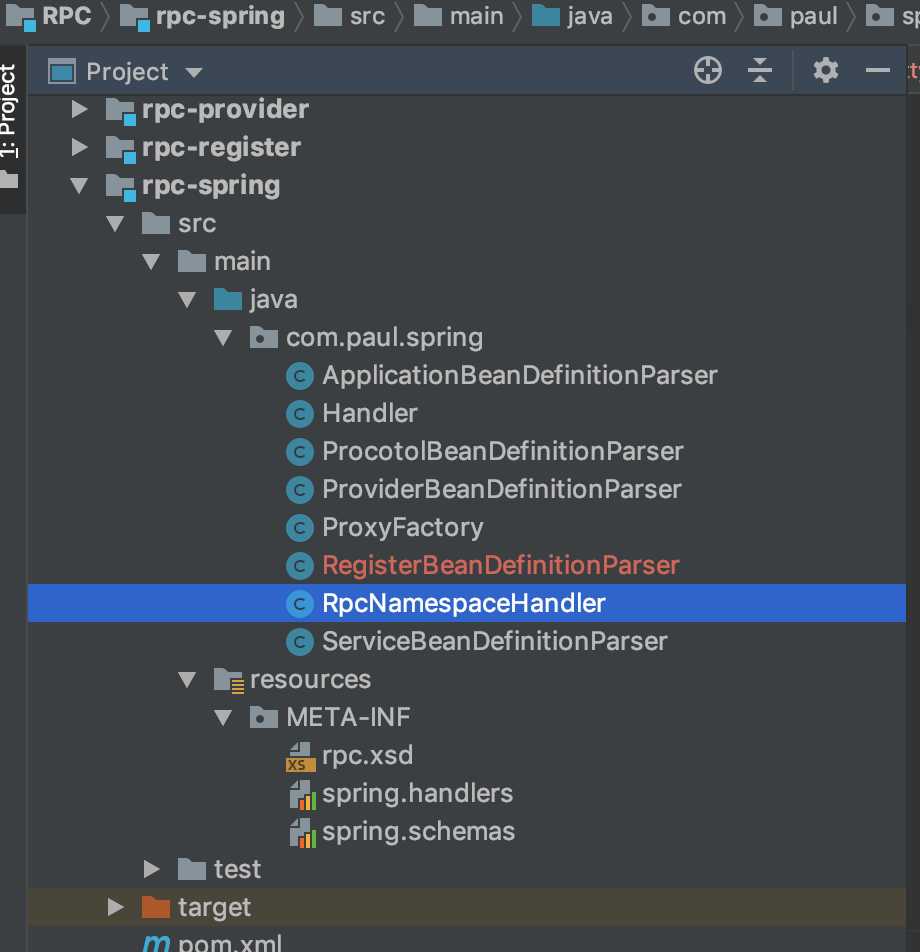带你手写基于 Spring 的可插拔式 RPC 框架代理类的注入与服务启动
Posted paulwang92115
tags:
篇首语:本文由小常识网(cha138.com)小编为大家整理,主要介绍了带你手写基于 Spring 的可插拔式 RPC 框架代理类的注入与服务启动相关的知识,希望对你有一定的参考价值。
上一章节我们已经实现了从客户端往服务端发送数据并且通过反射方法调用服务端的实现类最后返回给客户端的底层协议。
这一章节我们来实现客户端代理类的注入。
承接上一章,我们实现了多个底层协议,procotol 有 netty,http,和 socket 三个实现类,每个实现类都有启动服务端和客户端发送数据两个方法。
问题
- 如何实现底层协议的选择那?
可以通过配置文件来选择协议。 - 单独的配置文件还是和 Spring 的配置文件结合起来那?
我们选择与 Spring 结合的配置文件,自定义一些属性的标签,这样能够更好的利用 Spring 的特性。
自定义 Spring 标签
先看整体的结构:

写一个 xsd 文件来自定义我们的标签和属性,注意 schema 的 xmlns 和
targetNamespace 属性, http://paul.com/schema。<xsd:schema xmlns="http://paul.com/schema" xmlns:xsd="http://www.w3.org/2001/XMLSchema" targetNamespace="http://paul.com/schema"> <xsd:complexType name="procotol-type"> <xsd:attribute name="procotol" type="xsd:string"> <xsd:annotation> <xsd:documentation><![CDATA[ The elementname1 name. ]]></xsd:documentation> </xsd:annotation> </xsd:attribute> <xsd:attribute name="port" type="xsd:int"> <xsd:annotation> <xsd:documentation><![CDATA[ The elementname1 age. ]]></xsd:documentation> </xsd:annotation> </xsd:attribute> <xsd:attribute name="serialize" type="xsd:string"> <xsd:annotation> <xsd:documentation><![CDATA[ The elementname1 age. ]]></xsd:documentation> </xsd:annotation> </xsd:attribute> <xsd:attribute name="stragety" type="xsd:string"> <xsd:annotation> <xsd:documentation><![CDATA[ The elementname1 age. ]]></xsd:documentation> </xsd:annotation> </xsd:attribute> <xsd:attribute name="role" type="xsd:string"> <xsd:annotation> <xsd:documentation><![CDATA[ The elementname1 age. ]]></xsd:documentation> </xsd:annotation> </xsd:attribute> <xsd:attribute name="address" type="xsd:string"> <xsd:annotation> <xsd:documentation><![CDATA[ The elementname1 age. ]]></xsd:documentation> </xsd:annotation> </xsd:attribute> </xsd:complexType> <xsd:element name="procotol" type="procotol-type"> <xsd:annotation> <xsd:documentation><![CDATA[ elementname1的文档 ]]></xsd:documentation> </xsd:annotation> </xsd:element> <xsd:complexType name="application-type"> <xsd:attribute name="name" type="xsd:string"> <xsd:annotation> <xsd:documentation><![CDATA[ The elementname1 name. ]]></xsd:documentation> </xsd:annotation> </xsd:attribute> </xsd:complexType> <xsd:element name="application" type="application-type"> <xsd:annotation> <xsd:documentation><![CDATA[ elementname1的文档 ]]></xsd:documentation> </xsd:annotation> </xsd:element> <xsd:complexType name="service-type"> <xsd:attribute name="interfaces" type="xsd:string"> <xsd:annotation> <xsd:documentation><![CDATA[ The elementname1 name. ]]></xsd:documentation> </xsd:annotation> </xsd:attribute> <xsd:attribute name="ref" type="xsd:string"> <xsd:annotation> <xsd:documentation><![CDATA[ The elementname1 name. ]]></xsd:documentation> </xsd:annotation> </xsd:attribute> <xsd:attribute name="timeout" type="xsd:int"> <xsd:annotation> <xsd:documentation><![CDATA[ The elementname1 age. ]]></xsd:documentation> </xsd:annotation> </xsd:attribute> </xsd:complexType> <xsd:element name="service" type="service-type"> <xsd:annotation> <xsd:documentation><![CDATA[ elementname1的文档 ]]></xsd:documentation> </xsd:annotation> </xsd:element> <xsd:complexType name="provider-type"> <xsd:attribute name="interf" type="xsd:string"> <xsd:annotation> <xsd:documentation><![CDATA[ The elementname1 name. ]]></xsd:documentation> </xsd:annotation> </xsd:attribute> <xsd:attribute name="impl" type="xsd:string"> <xsd:annotation> <xsd:documentation><![CDATA[ The elementname1 name. ]]></xsd:documentation> </xsd:annotation> </xsd:attribute> </xsd:complexType> <xsd:element name="provider" type="provider-type"> <xsd:annotation> <xsd:documentation><![CDATA[ elementname1的文档 ]]></xsd:documentation> </xsd:annotation> </xsd:element> </xsd:schema>在自定义的 BeanDefinitionParser 来对我们自定义标签的属性进行解析。
在 BeanDefinitionParser 里面我们可以使用 Spring 的一些组件,也可以只将我们自定的属性解析出来。parse 方法里面传入的两个参数,通过 element 可以获得 xml 中的属性信息,通过 parserContext 可以获取到 BeanDefinitionRegistry,熟悉 Spring 源码的同学应该知道这个类,我们可以通过这个类将我们的类注入到 Spring 容器中。
构造方法中的 beanClass 我们可以传入自己定义的类,将解析出来的属性赋值到类的属性中。rpc:procotol 标签
这个标签中包含了协议类型,端口,序列化协议,注册中心地址和角色(服务端还是客户端)。这个标签解析中我们将一些属性赋值到了 Configuration 配置类中,根据属性选择了协议类型,如果是客户端,提前初始化出 channel 保存到阻塞队列中,提高并发能力,如果是客户端则启动通信服务器。客户端 procotol 标签配置:
<rpc:procotol procotol="Dubbo" port="3230" serialize="ProtoStuff" address="47.107.56.23:2181"/>服务端 procotol 标签配置:
<rpc:procotol procotol="Dubbo" port="3230" serialize="ProtoStuff" role="provider" address="47.107.56.23:2181"/>对应的解析器。
public class ProcotolBeanDefinitionParser implements BeanDefinitionParser private final Class<?> beanClass; public ProcotolBeanDefinitionParser(Class<?> beanClass) this.beanClass = beanClass; @Override public BeanDefinition parse(Element element, ParserContext parserContext) System.out.println("1"); String pro = element.getAttribute("procotol"); int port = Integer.parseInt(element.getAttribute("port")); Configuration.getInstance().setProcotol(pro); Configuration.getInstance().setPort(port); Configuration.getInstance().setSerialize(element.getAttribute("serialize")); Configuration.getInstance().setStragety(element.getAttribute("stragety")); Configuration.getInstance().setRole(element.getAttribute("role")); Configuration.getInstance().setAddress(element.getAttribute("address")); if("provider".equals(element.getAttribute("role"))) Procotol procotol = null; if("Dubbo".equalsIgnoreCase(pro)) procotol = new DubboProcotol(); else if("Http".equalsIgnoreCase(pro)) procotol = new HttpProcotol(); else if("Socket".equalsIgnoreCase(pro)) procotol = new SocketProcotol(); else procotol = new DubboProcotol(); try InetAddress addr = InetAddress.getLocalHost(); String ip = addr.getHostAddress(); if(port == 0) port = 32115; URL url = new URL(ip,port); procotol.start(url); catch (Exception e) e.printStackTrace(); else //获取服务注册中心 ZookeeperRegisterCenter registerCenter4Consumer = ZookeeperRegisterCenter.getInstance(); //初始化服务提供者列表到本地缓存 registerCenter4Consumer.initProviderMap(); //初始化Netty Channel Map<String, List<ServiceProvider>> providerMap = registerCenter4Consumer.getServiceMetaDataMap4Consumer(); if (MapUtils.isEmpty(providerMap)) throw new RuntimeException("service provider list is empty."); NettyChannelPoolFactory.getInstance().initNettyChannelPoolFactory(providerMap); return null;rpc:provider 标签,这个是服务端服务发布标签。通过这个标签表明服务端想要将哪些服务发布出来。
<rpc:provider interf="com.paul.service.HelloService" impl="com.paul.service.HelloServiceImpl" /> <rpc:provider interf="com.paul.service.UserService" impl="com.paul.service.UserServiceImpl" />对应的解析器:
将需要暴露的服务注册中 zookeeper。public class ProviderBeanDefinitionParser implements BeanDefinitionParser private final Class<?> beanClass; public ProviderBeanDefinitionParser(Class<?> beanClass) this.beanClass = beanClass; @Override public BeanDefinition parse(Element element, ParserContext parserContext) System.out.println("15"); String interfaces = element.getAttribute("interf"); String impl = element.getAttribute("impl"); int port = Configuration.getInstance().getPort(); InetAddress addr = null; try addr = InetAddress.getLocalHost(); String ip = addr.getHostAddress(); if(port == 0) port = 32115; List<ServiceProvider> providerList = new ArrayList<>(); ServiceProvider providerService = new ServiceProvider(); providerService.setProvider(Class.forName(interfaces)); providerService.setServiceObject(impl); providerService.setIp(ip); providerService.setPort(port); providerService.setTimeout(5000); providerService.setServiceMethod(null); providerService.setApplicationName(""); providerService.setGroupName("nettyrpc"); providerList.add(providerService); //注册到zk,元数据注册中心 RegisterCenter4Provider registerCenter4Provider = ZookeeperRegisterCenter.getInstance(); registerCenter4Provider.registerProvider(providerList); catch (UnknownHostException e) e.printStackTrace(); catch (ClassNotFoundException e) e.printStackTrace(); return null;rpc:service 标签,这个标签表明客户端需要调用哪些服务端的接口,将对应的代理类注入到 Spring 中,在成需中可以直接使用 @Autowired 注入这个代理类,就可以像调用本地服务一样调用远程服务了。
<rpc:service interfaces="com.paul.service.HelloService" ref="helloService" timeout="5000"/>对应的解析器:
将接口的代理类注入到 Spring 中,并且将消费者也就是客户端注册到注册中心。public class ServiceBeanDefinitionParser implements BeanDefinitionParser private final Class<?> beanClass; public ServiceBeanDefinitionParser(Class<?> beanClass) this.beanClass = beanClass; @Override public BeanDefinition parse(Element element, ParserContext parserContext) String interfaces = element.getAttribute("interfaces"); String ref = element.getAttribute("ref"); Class clazz = null; try clazz = Class.forName(interfaces); catch (ClassNotFoundException e) e.printStackTrace(); BeanDefinitionBuilder builder = BeanDefinitionBuilder.genericBeanDefinition(clazz); GenericBeanDefinition definition = (GenericBeanDefinition) builder.getRawBeanDefinition(); definition.getConstructorArgumentValues().addGenericArgumentValue(clazz); definition.setBeanClass(ProxyFactory.class); definition.setAutowireMode(GenericBeanDefinition.AUTOWIRE_BY_TYPE); BeanDefinitionRegistry beanDefinitionRegistry = parserContext.getRegistry(); beanDefinitionRegistry.registerBeanDefinition(ref,definition); //获取服务注册中心 ZookeeperRegisterCenter registerCenter4Consumer = ZookeeperRegisterCenter.getInstance(); //将消费者信息注册到注册中心 ServiceConsumer invoker = new ServiceConsumer(); List<ServiceConsumer> consumers = new ArrayList<>(); consumers.add(invoker); invoker.setConsumer(clazz); invoker.setServiceObject(interfaces); invoker.setGroupName(""); registerCenter4Consumer.registerConsumer(consumers); return definition;定义一个 NamespaceHandler 来注册对应的标签和 BeanDefinitionParser。
public class RpcNamespaceHandler extends NamespaceHandlerSupport @Override public void init() registerBeanDefinitionParser("procotol", new ProcotolBeanDefinitionParser(Configuration.class)); // registerBeanDefinitionParser("register", new RegisterBeanDefinitionParser(Configuration.class)); registerBeanDefinitionParser("application", new ApplicationBeanDefinitionParser(Configuration.class)); registerBeanDefinitionParser("provider", new ProviderBeanDefinitionParser(Configuration.class)); // registerBeanDefinitionParser("role", new ServerBeanDefinitionParser(Configuration.class)); registerBeanDefinitionParser("service", new ServiceBeanDefinitionParser(Configuration.class));在 Spring 中注册上面的 schema 和 handler。
spring.handlers, 这里要将 schema 和我们自定义的 handler 类 mapping 起来。http\\://paul.com/schema=com.paul.spring.RpcNamespaceHandlerspring.schema,表明 xsd 文件的位置。
http\\://paul.com/schema/rpc.xsd=META-INF/rpc.xsd通过上面的配置我们实现了根据配置来做通信协议,序列化协议的选择以及客户端代理类注入到 Spring 中方便我们以后调用,还实现了服务端的启动,以及对应注册到注册中心的功能。
获取接口代理类的实现
我们使用的是 JDK 动态代理。
```java
public class ProxyFactory
private Class
private ApplicationContext ctx;
public ProxyFactory(Class<T> interfaceClass)
this.interfaceClass = interfaceClass;
@Override
public T getObject() throws Exception
return (T)Proxy.newProxyInstance(interfaceClass.getClassLoader(), new Class[]interfaceClass, new Handler(interfaceClass));
@Override
public Class<?> getObjectType()
return interfaceClass;
```
Invocation 的实现类 handler, 也就是动态代理类的 invoke 方法的调用,通过 invoke 方法调用对应协议的 send 方法去发送数据。在发送数据前,通过负载均衡策略选择对应的服务端地址,拼装 RpcRequest 调用 proctol 接口实现类的 send 方法发送数据。
```java
public class Handler
private Class<T> interfaceClass;
public Handler(Class<T> interfaceClass)
this.interfaceClass = interfaceClass;
@Override
public Object invoke(Object proxy, Method method, Object[] args) throws Throwable
Configuration configuration = Configuration.getInstance();
Procotol procotol;
if("Dubbo".equalsIgnoreCase(configuration.getProcotol()))
procotol = new DubboProcotol();
else if("Http".equalsIgnoreCase(configuration.getProcotol()))
procotol = new HttpProcotol();
else if("Socket".equalsIgnoreCase(configuration.getProcotol()))
procotol = new SocketProcotol();
else
procotol = new DubboProcotol();
//服务接口名称
String serviceKey = interfaceClass.getName();
//获取某个接口的服务提供者列表
RegisterCenter4Consumer registerCenter4Consumer = ZookeeperRegisterCenter.getInstance();
List<ServiceProvider> providerServices = registerCenter4Consumer.getServiceMetaDataMap4Consumer().get(serviceKey);
//根据软负载策略,从服务提供者列表选取本次调用的服务提供者
String stragety = configuration.getStragety();
if(null == stragety || stragety == "")
stragety = "random";
System.out.println("paul:"+ providerServices.get(0).toString());
LoadStrategy loadStrategyService = LoadBalanceEngine.queryLoadStrategy(stragety);
ServiceProvider serviceProvider = loadStrategyService.select(providerServices);
URL url = new URL(serviceProvider.getIp(),serviceProvider.getPort());
String impl = serviceProvider.getServiceObject().toString();
int timeout = 20000;
RpcRequest invocation = new RpcRequest(UUID.randomUUID().toString(),interfaceClass.getName(),method.getName(),args, method.getParameterTypes(),impl,timeout);
Object res = procotol.send(url, invocation);
return res;
```
这样我们完成 rpc-spring 模块的代码。
以上是关于带你手写基于 Spring 的可插拔式 RPC 框架代理类的注入与服务启动的主要内容,如果未能解决你的问题,请参考以下文章
带你手写基于 Spring 的可插拔式 RPC 框架通信协议模块